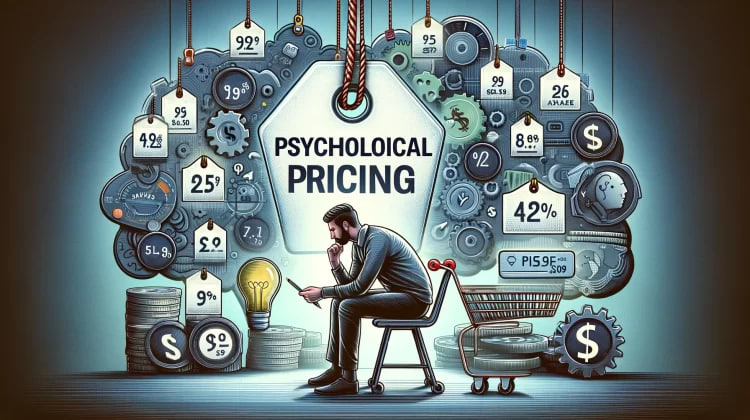15 Pricing Strategies for Consulting Services
Did you know that the average hourly rate for consultants can reach up to $400? This means that having the right pricing for your services is a critical factor for achieving financial success.
In this article, we will explore 15 innovative pricing strategies specifically designed to help consultants enhance their market position and boost their profits. We will cover a wide range of factors to consider when setting your service fees, including your clients' needs, financial goals, and market competition.
This article will answer questions like:
- On what basis should I determine my consulting fees?
- What are the best pricing models in the consulting field?
- How do I choose a profitable pricing framework for my consulting services?
- Why is it so important to choose the right pricing strategy?
The Impact of Pricing Models on Business Success
Choosing the right pricing model impacts not only profitability but also other business-related factors, including:
1. Perceived Value
Perceived value refers to the benefits a client receives in exchange for the fee they pay for your services. If your fees are too low, clients might assume your services are of low quality.
Conversely, if your fees are too high, clients may perceive you as overpriced and expect a flawless service. Therefore, choosing the right pricing model is essential to ensure your work is properly valued.
2. Market Positioning
The right pricing plan helps solidify your presence in the market. This ensures you attract the right clients for your business. It is vital to adjust your consulting fees as your business grows, your expertise increases, and your skills evolve.
3. Profitability
While charging low fees might attract many clients, it could lead to financial instability and burnout. On the other hand, charging high fees can deter potential clients, leading to a loss of business in the long run. The right pricing strategy strikes a balance, attracting potential clients while maintaining a healthy profit margin.
4. Client Expectations
When you charge a high fee, clients expect excellent service. Conversely, when you charge a low fee, their expectations are often lower as they associate it with a lower standard of quality. For this reason, you need to set a fee that aligns with both your clients' expectations and the effort you put in.
15 Methods Smart Pricing for Profitable Consulting
Now, let’s explore 15 pricing strategies for consulting services.
1. Hourly Pricing
Hourly pricing is a common approach for consultants, freelancers, and other service-based professionals. It is a straightforward and transparent strategy where fees are calculated based on the time spent on a project or service. This approach directly links the compensation to the effort invested, allowing consultants to track their time accurately and ensuring they are fairly compensated.
A major advantage of hourly pricing is that it allows for increased revenue as project hours increase, making it suitable for projects with a varying scope. However, it may be less effective for long-term projects, as it can be difficult to estimate the total hours accurately.
Pros
- Transparent and easy to calculate, as you can track your work hours.
- Ideal for short-term projects with variable scope.
Cons
- Can be difficult to estimate time, leading clients to feel they are paying for slow or inefficient work.
- Focuses on billable hours rather than the value delivered.
2. Project-Based Pricing
This strategy involves charging a fixed fee for an entire project, rather than billing by the hour. You set the price based on the project's scope, duration, and required effort.
This provides clients with a clear pricing plan and motivates you to complete the project efficiently within the agreed-upon timeframe.
The main challenge with project-based pricing is accurately estimating the project's cost upfront. To succeed with this strategy, you must define the project scope with precision.
It is widely used by marketers and consultants for projects with specific requirements and is also suitable for freelancers and agencies handling large or complex projects with well-defined deliverables and timelines.
For example, an HR consultant might charge a flat fee of $10,000 to develop a performance management program. This fee, based on estimated time and resources, can lead to higher profit margins.
Pros
- Clear scope of work and deliverables.
- Allows clients to budget accurately for their specific needs.
Cons
- Difficult to estimate project costs accurately.
- Scope creep can lead to budget overruns.

3. Value-Based Pricing
This strategy determines fees based on the impact and value your services create for your client's business. The more value you deliver, the higher your fee. This approach incentivises you to deliver exceptional results and can lead to higher consulting fees for future projects, as well as increased client loyalty and stronger partnerships.
Value-based pricing is best suited for consultants who provide highly specialised, high-impact services that deliver significant value. It is ideal for consultants targeting a niche market where clients are willing to pay a premium for exceptional results.
Pros
- Consultants' fees are directly aligned with the value they provide.
- Allows consultants to achieve higher profits.
Cons
- Requires a deep understanding of the client's project to be successful.
- The value delivered can sometimes be difficult to quantify.
4. Retainer-Based Pricing
Retainer agreements are used to establish an ongoing, long-term relationship with clients. It is a contract where you agree to provide services for a specific period in exchange for a recurring fee. When setting the price, you consider the scope of services, your expertise, and the time and effort required. Some consultants charge a fixed monthly fee, while others bill hourly. This strategy benefits both parties.
Pros
- Provides consultants with a stable and consistent income stream.
- Fosters long-term client relationships.
Cons
- Clients may feel they are paying for services they don't fully use.
- Scope creep can lead to working more hours than expected without additional compensation.
5. Competitive Pricing
This strategy, used by independent consultants and firms, is based on market competition. By conducting proper research, you can compare your prices with those of your competitors and set your fees to attract new clients and retain existing ones.
This strategy must allow for a reasonable profit margin to be sustainable in the long term. It also enables consulting firms to easily enter new markets. Competitive pricing is suitable for certain industries and for targeting a specific audience. For example, if you are targeting a broad audience, a lower fee may be more viable.
Pros
- Effective in competitive markets as it aligns your prices with industry standards.
- Easy for clients to understand and compare against other service providers.
Cons
- Does not account for the consultant's unique skills or expertise.
- Can lead to fierce price wars and doesn't always cover actual business costs.
6. Cost-Plus Pricing
This model accounts for operational costs plus a profit margin, ensuring that every project is profitable. It is suitable for consultants who can accurately calculate their operating expenses, time, and resources needed for a project. It is also ideal for businesses that value transparency in pricing.
For example, a graphic designer needs 20 hours for a client's branding project. The total project costs, including software licenses and office space, might be $3,000.
By adding a 30% profit margin, the total fee would be $3,900. This approach guarantees that costs are covered, and a profit is made.
Pros
- Ensures profitability when costs and resources are managed efficiently.
- Guarantees that all operating expenses are covered.
Cons
- Does not consider competitors' pricing.
- Fails to account for the value delivered to the client.
7. Dynamic Pricing
This model allows you to set consulting fees based on market demands and other external factors. You must monitor market trends and demand patterns to set a timely pricing plan.
It is an effective way to increase revenue, as you can charge higher prices during peak market periods and lower them during slumps.
However, dynamic pricing requires a sophisticated pricing algorithm and data analysis tools. Price fluctuations can lead to client dissatisfaction.
This strategy is best for consultants working in markets with fluctuating demand, such as travel and technology consulting.
For example, a software consultant may charge a higher hourly rate during high-demand periods, while a financial consultant may charge more at the end of the fiscal year.
Pros
- Responds quickly to changes in market conditions or demand.
- Maximises profit margins during peak periods.
Cons
- Can be difficult to justify price fluctuations to clients.
- Market volatility can lead to client dissatisfaction.

8. Market Penetration Pricing
As the name suggests, this strategy is used by consultants and firms to enter a market. They charge low fees compared to the market average to increase sales volume. This makes it suitable for consultants launching a new service or entering a new market.
One limitation of market penetration pricing is that it can lead to price wars, making it unsustainable long term. For example, a new marketing consultant might offer a 20% discount for the first three months to attract new clients and quickly gain market share. This makes the service affordable and appealing to price-conscious clients.
Pros
- Useful for building a customer base quickly.
- Effective for rapidly gaining market share.
Cons
- Involves the risk of low profit margins in the short term.
- May not be suitable for the long term.
9. Premium Pricing
This strategy is used by consultants offering luxury, unique, or exclusive services. You charge higher fees than the market average, with the goal of positioning your offerings as exclusive and high-end. This allows you to generate significant profits from a specific audience, though it limits your customer base.
Premium pricing is often used by consultants with extensive expertise and experience. When adopting this strategy, you must consider market demand and your unique value proposition.
Pros
- Enhances the firm's image as a luxury service provider.
- Enables consultants to set a higher profit margin.
Cons
- Limits the firm’s opportunities to expand to a broader audience.
- Makes it difficult to compete in price-sensitive markets.
10. Psychological Pricing
This model is based on the psychological impact you create on your clients. It leverages human behaviour and emotions to persuade clients to purchase your services. This allows a consultant to set fair prices while maximising revenue.
Common techniques include "charm pricing", where you price a service at $99 instead of $100 to make it seem significantly cheaper.
Another technique is to offer a range of options at different price points, giving clients a sense of control over their purchasing decisions. While this strategy can boost sales, overuse may harm your brand's reputation.
Pros
- Can influence the perceived value of your services.
- Provides opportunities to increase sales and revenue.
Cons
- Can be difficult to implement effectively.
- May be perceived as unethical or less transparent.

11. Geographical Pricing
This strategy is used by consultants who operate in different geographical regions. It takes into account factors such as average income, cost of living, competition, and local demand.
This approach requires adjusting prices based on the specific location. For example, an international consultant may charge different fees to clients in different countries.
However, price differences can lead to issues unless you communicate with your clients clearly and transparently.
Pros
- Considers regional differences in service costs and demand.
- Helps businesses align their prices with local markets while remaining competitive.
Cons
- May be ineffective in global or national markets.
- Price differences can create problems if not handled carefully.
12. Price Skimming
This strategy involves setting high prices initially and then gradually lowering them over time. It is ideal for launching a new product or service, as it allows you to capitalise on early adopters who are willing to pay a premium for the newest offering.
This approach is beneficial because it generates revenue quickly, which can be reinvested in further research. However, it can also create an impression of exclusivity and limit your customer base.
Price skimming is mostly used by consultants who offer unique services that competitors cannot provide. For example, a travel company might offer exclusive tours to an unexplored area.
Pros
- Useful for improving brand reputation and increasing profit margins.
- Enhances your business image as a premium service provider.
Cons
- Limits the consulting firm’s market reach.
- Not sustainable in the long run.
13. Freemium Pricing
This strategy involves offering a basic version of your services for free while charging for premium versions. Consultants can use this model to boost brand awareness and build trust with their target audience. This is a common strategy in the Software as a Service (SaaS) sector.
For example, a marketing consultant might offer a free initial consultation to discuss a potential client's needs and challenges, then charge for additional services like a full strategic marketing plan.
While this strategy can attract a large number of clients, you must find a proper balance between free and paid packages to avoid a lack of revenue, as some clients may be satisfied with the free version and never upgrade.
Pros
- Attracts a large number of clients quickly.
- Effective in markets with low barriers to entry.
Cons
- Can lead to low profit margins in the short term.
- May be impractical for the long term.
14. Bundle Pricing
As the name suggests, this strategy allows you to combine various services and sell them together for a single price. Bundle pricing can increase sales by encouraging clients to buy more than they originally intended.
One of its advantages is increased client loyalty, as it provides a convenient and cost-effective way to purchase multiple services. However, this strategy is only successful if you can convince your clients that the bundled services are complementary and useful.
For example, a marketing consultant might offer a package including social media management, email marketing, and content creation services at a discounted price.
This strategy is ideal for firms looking to promote new services, such as a business coach who bundles face-to-face coaching with course materials.
Pros
- Increases sales and revenue.
- Encourages clients to purchase more than one service.
Cons
- Can be difficult to explain the value of the package.
- Unsuitable for clients who only need specific services.
15. High-Low Pricing
This model involves setting high prices when a service is first launched and then gradually lowering them to stimulate demand. The goal is to position the offering as high-quality and exclusive, then later attract price-conscious clients.
This clever approach creates a buzz about your new services and attracts premium clients. However, the risk is that clients may feel deceived in the long run if they discover that the same service is later sold at a lower price.
Unlike price skimming, high-low pricing involves more sudden price changes, making it suitable for companies offering new and unique services that competitors might eventually imitate.
For example, a consultant might offer a comprehensive retail business analysis package for $75,000 and then lower the fee over time to $60,000 to expand their client base.
Pros
- Allows you to attract price-conscious clients while maintaining profitability.
- Creates a sense of urgency for clients to buy at specific times.
Cons
- Can create the impression that your services are inconsistent in value.
- Difficult to justify price changes to clients.
Choosing the Right Pricing Model for Your Consulting Firm: Adopt the Top 5 Best Practices
Before choosing from the strategies above, consider common pricing concerns to determine the following:
- Target Audience and Budget: Define your ideal client and buyer persona to set the right price for your services.
- Costs and Overheads: Account for all fixed and variable costs and potential overheads.
- Revenue and Profit Margins: Determine your desired revenue goals.
Considering all these factors, here is a step-by-step process to discover the ideal pricing system for your consulting firm:
1. Identify Your Firm’s Strengths and Weaknesses
Define your unique selling points and weaknesses to choose the perfect strategy. For example, if your services offer innovative solutions, value-based pricing might be the right choice. If your services are based on ongoing projects, then retainer-based or hourly pricing would be more suitable.
2. Understand Your Target Client's Needs
Analyse your client’s needs and preferences to find the right model. For example, a price-sensitive client might prefer project-based or bundle pricing. On the other hand, clients who prioritise results might prefer performance-based pricing.

3. Evaluate Your Competitors' Prices
This is essential for those new to the market. Identify opportunities or gaps in your competitors' pricing models to gain a competitive edge. For example, if your competitor only offers project-based pricing, you could gain an advantage by also offering value-based or retainer-based pricing.
4. Study Market Trends and Demands
Stay informed about market demands and competitors to choose the best model. If the target market requires customised solutions, adopting value-based pricing benefits your firm. However, hourly or project-based models are better if the market demands standard services.
5. Conduct a Test to Refine Your Strategy
After analysing all factors and deciding on a strategy, test it before a full rollout. Start by testing the strategy with a small group of potential clients and gather feedback. For example, if you test value-based pricing, you should refine it to align with the value clients expect.
Here are some tips to refine your pricing system:
- Offer tiered pricing to meet different client needs and budgets.
- Bundle your services into packages to increase perceived value and encourage clients to spend more.
- Offer significant discounts to attract new clients and motivate them to buy additional services.
- Be transparent about your prices to build client trust.
- Review your pricing strategy regularly to avoid missing opportunities.
In Conclusion
First, remember that choosing the right pricing strategy is crucial for consultants. It not only determines your profitability but also the quality of your work, your market position, and the value of your services. Choose a framework from the strategies above that helps you set the right price for your consulting services.
In this competitive environment, client expectations are constantly changing, so you must be mindful when choosing strategies that suit your target clients and align with your revenue goals. If your firm can provide the right solutions, it will lead to increased sales. Finally, don't forget to continuously refine your pricing strategy based on the current market and client demand.
Many companies hire pricing strategy consultants to help them decide on their product or service prices. However, hiring a consultant can be a financial burden. By applying the practices mentioned above, you can choose the ideal pricing framework yourself.
مساحة اعلانية
أحدث المقالات
ابق على اطلاع بآخر المستجدات
کن على اطلاع بآخر المقالات والمصادر والدورات القادمة









